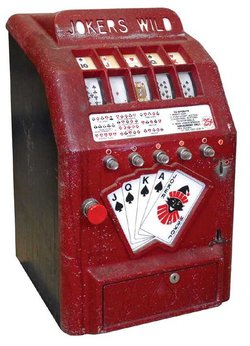- Home
- Replacement Artwork,logos,etc Available
- The Allwin Arcade
- Trade Stimulators
- The Strange & Unusual
- The Aristocrat Collection
- The Bally Collection
- The Bell-Fruit collection
- The BDR/BMR Collection
- The Bryans Collection
- The Buckley collection
- Caille Brothers Collection
- Working Models
- The Groetchen collection
- The Hawtin's Collection
- The Jamieson's Collection
- The Jennings collection
- The Mills Collection
- The NSM (Bingen) Collection
- The Oliver Whales Collection
- The Pace Collection
- The Parkers Collection
- The Rock-ola collection(slot machines)
- The Ruffler & Walker Collection
- The SEGA Collection
- the Shefras collection
- The TH.Bergmann Collection
- The Tom Boland collection
- The Watling collection
- The Whittaker Bros Collection
- the Wondermatics collection
- The Wulff Collection
- The Juke Box Age
- Coin Operated Cranes & Diggers
- Coin Operated Shooting Games
- Coin Operated Weight Scales
- slot machine coins & tokens for sale
- Amusement Arcades from the Past
- The British Seaside Pleasure Pier
- The Market Place
- Coin Operated Related Seaside Postcards
- See a Selection of the More Complex Machines at Work
- Stuart Dale's Imperator Rebuild
- Stuart Dale's Steam Shovel Project
- The "Allwin" Machine
- Useful Links
- The Rye Heritage Ctr Collection of Working Models
- Williamson's Vintage amusement arcades
- Contact Us

Trade Stimulators
Trade stimulators are one of the strangest areas of coin-operated slot machine history. At their peak, they often took the form of a true one arm bandit style slot machine( all be it a small one with no automatic payout) yet remained so different in their usage that they are never looked at as being the same as a standard slot machine. even the name is confusing until you look a little deeper into their use as it's hard to see how these would stimulate trade.
Whereas it might be true to say the gambling slot machine started life in towns (or at least in the saloon) it would be just as fair to say the trade Stim started life in more rural areas (or at least in the general store).
The first of the genre was most likely the simple punch(or pin) board where a customer paid for a chance to push out a pinhole in a board of at least 100 in the hope of pushing out a ticket indicating a prize. This, like all those to follow, was, strictly speaking, illegal gambling and the term "trade stimulator" may have come along at this time in a feeble attempt to cover the gambling aspect by saying the thing simply encouraged customers to use your shop/bar because this source of fun was available.
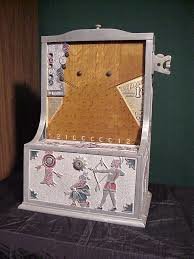
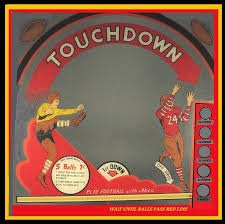
Drop coin & coin flick machines like these (these two are in fact later designs) were among the first cased "Trade Stims" to stand freely on the counter, their real purpose was more likely to grab the small change returned to a customer after a sale, after WW2 when the Trade Stim market declined this type of machine-made a comeback
By the end of the 19th cent, the first mechanical coin-operated trade stims could be found in bars and on shop counters alongside the many coin drop and flick coin/ball machines that had already become popular. One of the biggest early successes was the "bicycle " a version of which was made by several companies and in several styles using the new popularity of the bicycle as a feature.
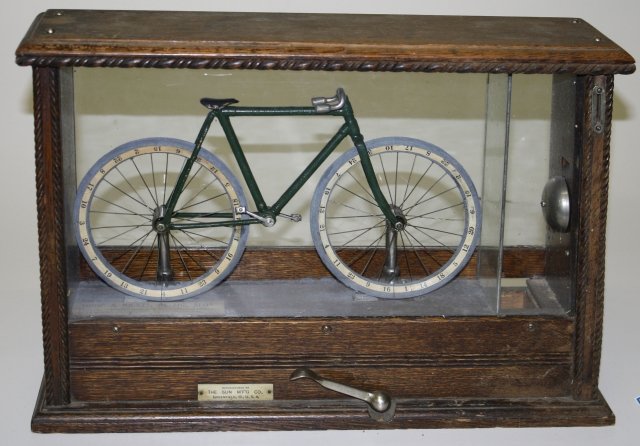
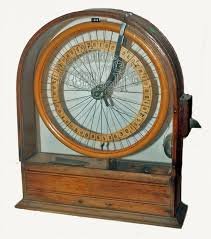
Two versions of the "Bicycle" trade stimulator
Sun "bicycle" Trade Stimulator (1895) in action
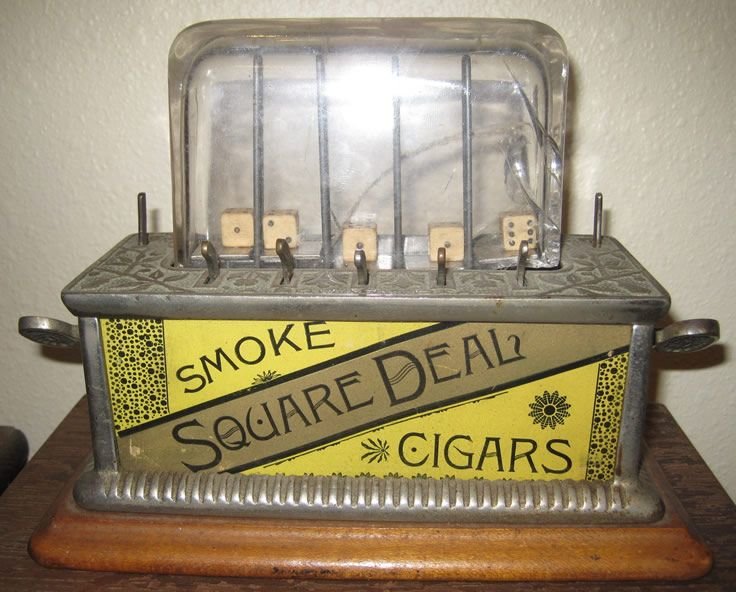
This early dice machine most likely doubled as a counter game where the player paid to play and perhaps win a cigar and a unit lent/hired out to groups of customers so they could play against each other while drinking
It is fair to say some of the very early mechanical trade stims did (indirectly at least) lead to extra sales as these were often lent or hired out to groups of customers to play against each other, often to decide who bought the next round of drinks. Dice throwing machines were very popular in these early days. This type of machine did persist right through the trade stim era but it was another type of machine that caught the imagination of the public and became the standard trade stim. These took the form of a small one arm bandit machine operating on very small coinage (often just 1c) and paying out in goods usually cigars, cigarettes. beers or a redeemable token although this last option was rare as most of these machines had no actual payout system and relied on the barman/counter assistant checking the result and paying out the prize. most of the big makers especially Mills were making this type of Trade Stim by 1900, The reel strips tended not to show dice as dice machines were already plentiful so, for the most part, playing cards were the order of the day in the early days.
At this time cigars may have been the number one prize, more popular in the USA than cigarettes at that time a fine cigar was considered the perfect accompaniment to a beer at the bar. The common phrase "close but no cigar" springs from these machines.
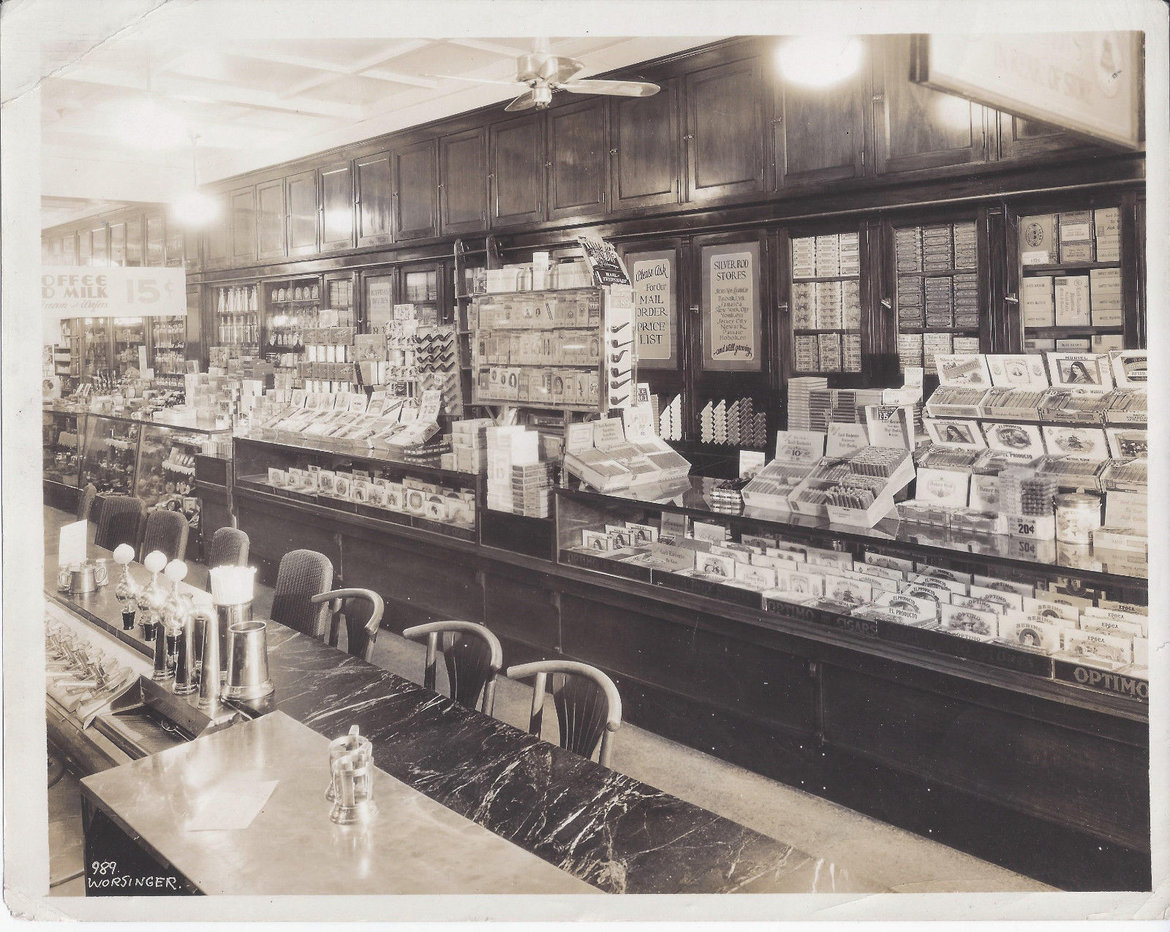
It's hard for us today to imagine the cigar culture that existed in the USA from the early 19th cent until the 1930's, the photo above is not a cigar shop as such only the cigar counter in a bar/drug store
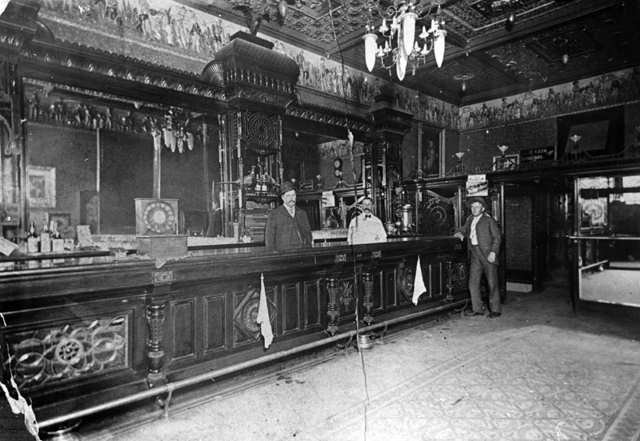
This early bar photo clearly shows a wheel type trade stim on the counter
note the spittoons are discreetly placed inside the foot rail, must have been a class establishment
Although often openly displayed on the counters of shops and bars these machines were a form of illegal gambling and, in an attempt to get around the law, the vast majority of the later machines came with a gumball dispenser, the claim being that the player was buying a gumball with each play and the game was just a bit of harmless fun offered for free. The truth was the gumball was rarely claimed by the player who was only interested in winning a prize. Those machines that did payout a coin or (more likely) a token did it in what was called a "discreet manner" the token emerging from a small opening on the side of the machine with the machine carrying no flashy information about payouts.
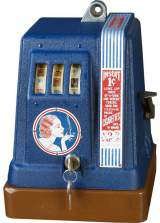
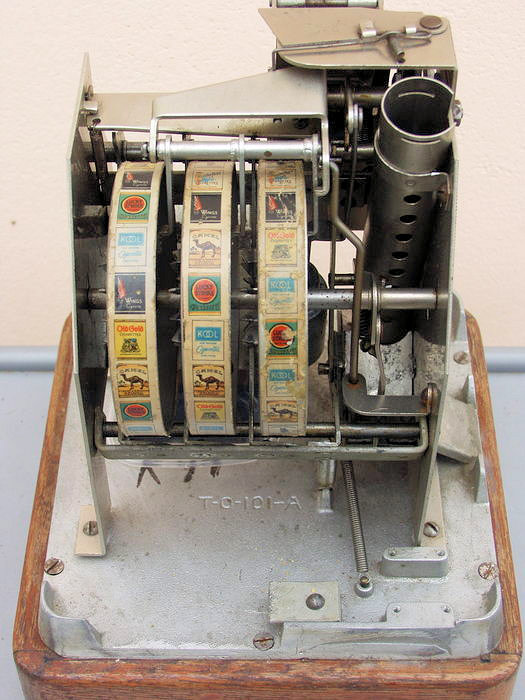
In 1937 the always innovative Groetchen tool Co tried something new and it was a big success, The "Ginger" was a token paying machine with no Gumball dispenser. It was a risk as this machine is clearly a gambling device. Their thinking was most likely that Trade Stims had been around for so long, and were so common that the law wasn't going to bother with them, this seems to have been the case and the Ginger was followed by similar machines like the Sparks, Liberty and Mercury, all available with cigarette reels, fruit reels and even fortune-telling reels. The token payout was the real disguise for it meant no prize list was needed on the machine as the winnings were directly printed on the token ("1 packet" "4 packets" 1 beer" etc) and the "discrete" side payout kept the token out of site. Groetchen were masters of building small mechanisms and adding a payout was not a problem for their engineers. What slot collector could resist that stylized 30's lady smoking a cigarette!!
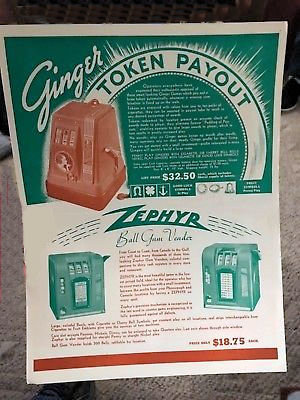
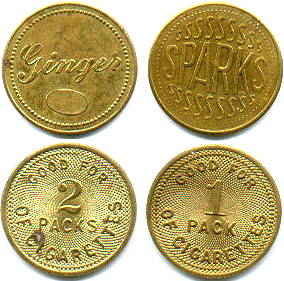
Case design was a key feature in Trade stims, they needed to be small but seen and this, often innovative artwork makes these machines very collectable today
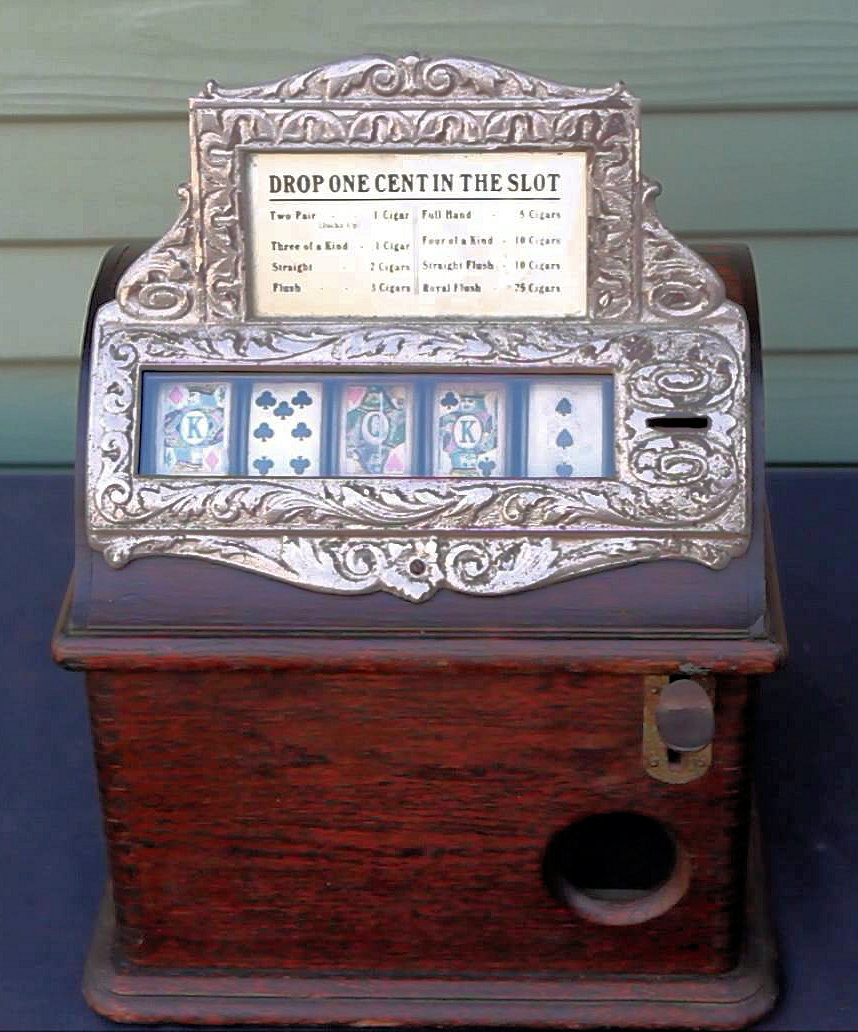
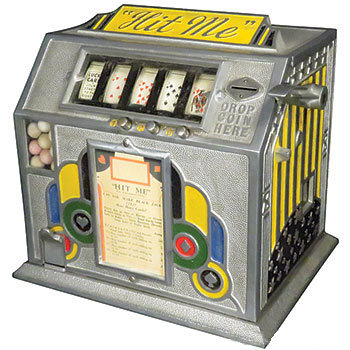
This 1904 Caille "Good Luck" was itself a rehash of an earlier model but still retained the ornate design typical of its era, By 1934 this Pierce "Hit Me" was doing exactly the same with its "Deco" style design.
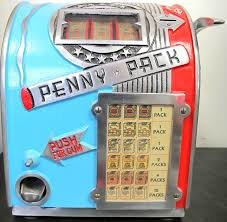
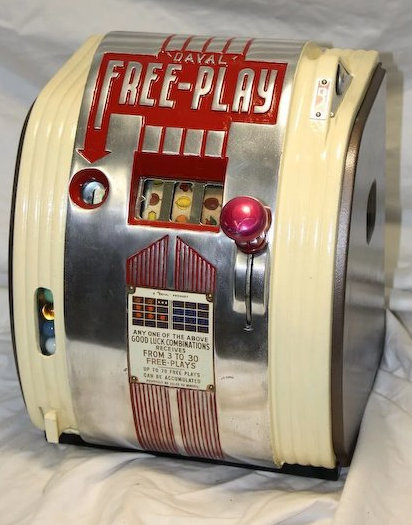
For me personally, the best designs come in the late period, these two Daval machines are classics no
doubting the "Penny Pack" payout
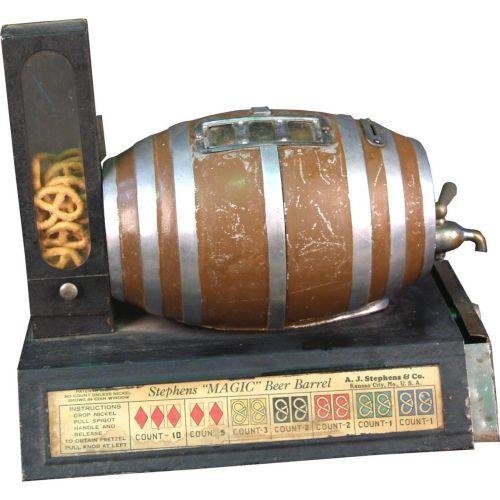
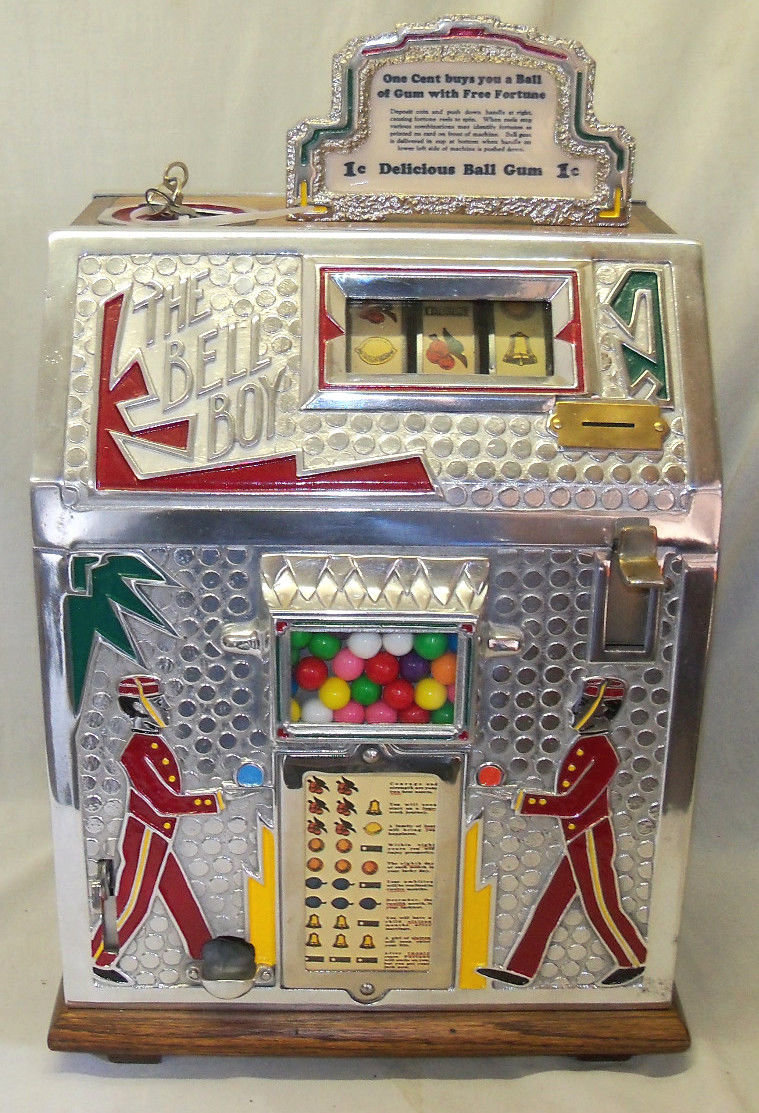
No doubting where this early Stevens "Magic Beer Barrel" The "Bell Boy" didn't even offer you a prize, just
was intended for use a gumball and your fortune told, or perhaps that fortune
held another meaning for the bartender?
Strangely the trade stim was an idea almost unique to the USA. They could be found in other countries but in very limited numbers. The border towns of Canada and Mexico certainly had them but this was due to the large numbers of Americans crossing the border to take advantage of the more relaxed gambling and (later) drinking laws (and as far as Mexico was concerned, other illegal entertainments on offer) across the border. They did crop up in English pubs all be it in different, usually uninteresting, forms. The only ones in the UK that stood the test of time were those used as charity collecting boxes giving the player a free game of some sort for his donation. They could be found in several other countries but in tiny numbers
One of the more interesting differences between the bandit and the trade stim was the reel strips, whereas most one-arm bandits in the USA at the time used the well-known fruit symbols on their reels trade stims rarely used these preferring to use playing cards, dice, cigarette packet designs, beer and drink symbols, horse racing symbols or numbers. The cigarette packet reel strips were particularly popular during the '30s with the payouts linked to the packet designs," 3 Camel packets shown in a row pays 5 packets of cigarettes" for example. There was even one dice machine where the dice had cigarette packets printed on them rather than numbers, two of a kind won you 1 packet of that particular cigarette three of a kind won you 5 packets.
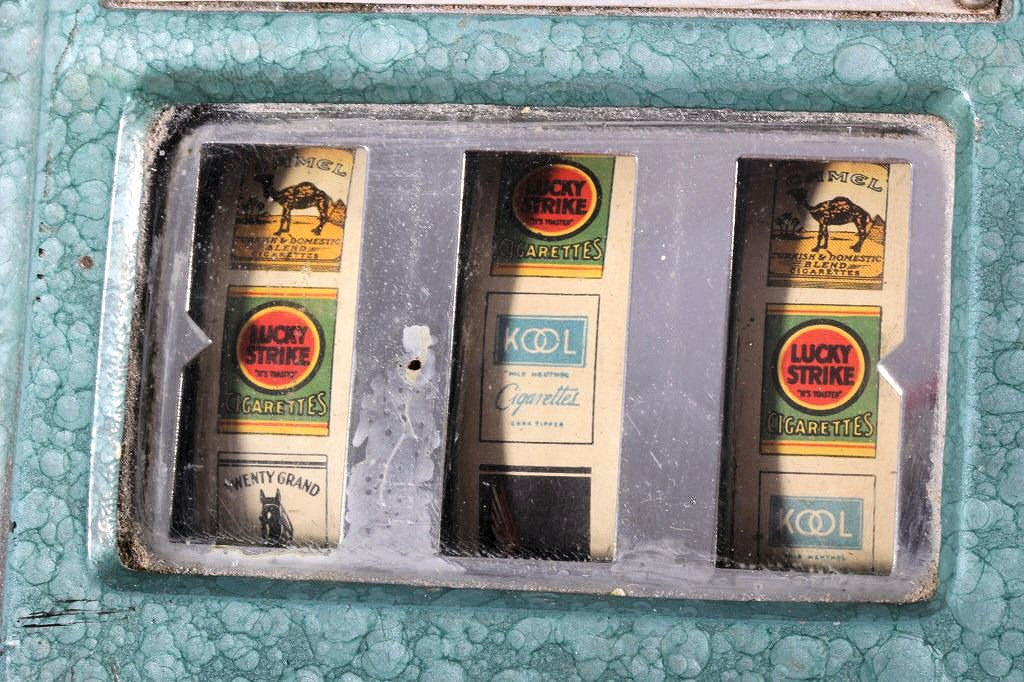
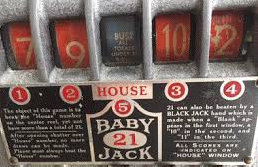
The popular cigarette reel strips, these ones are pre-WW2 numbers strips used on "21" game machines
identifiable by the green "lucky Strike" packets this was easier than using playing card strips
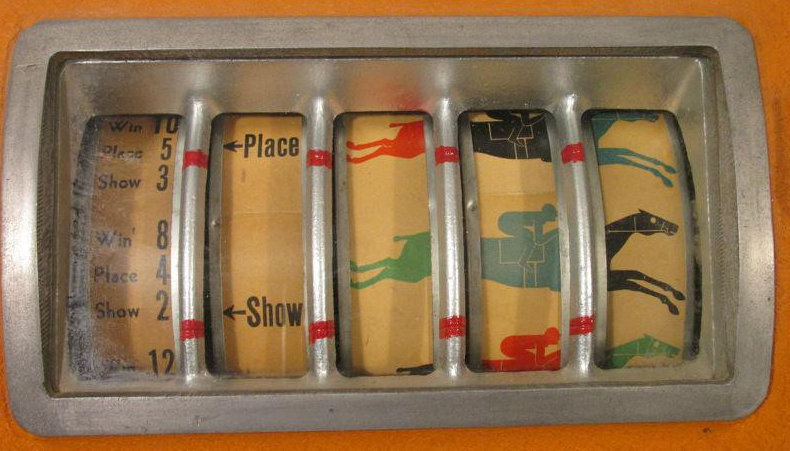
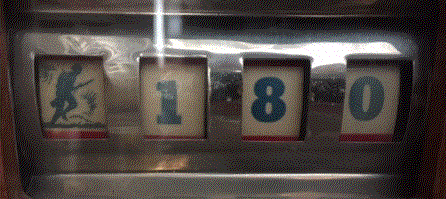
Horse race-themed strips were less common, these are These "Doughboy" strips are very rare
from a Groetchen "High Stakes" and show odds and type of payout
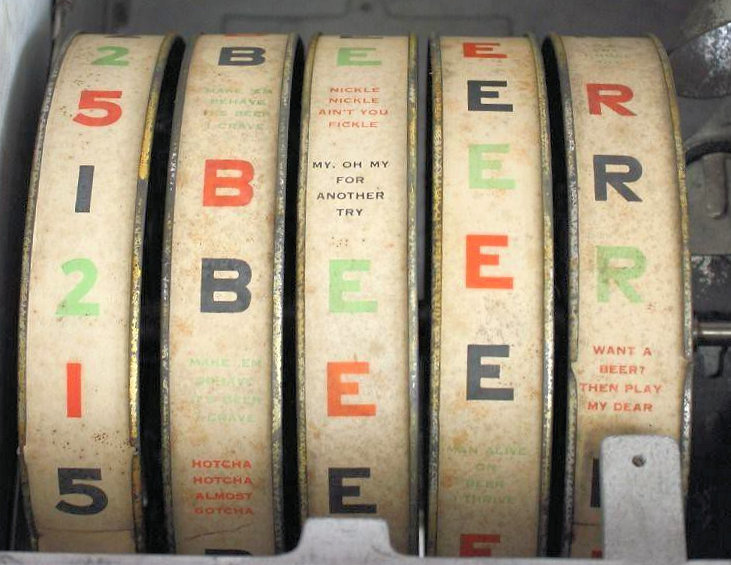
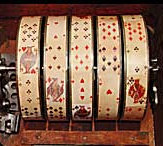
These "BEER" strips are from a Pace machine Originally the most popular style of strip was the playing
spell out the word BEER all in one colour and win card, they became less popular over time
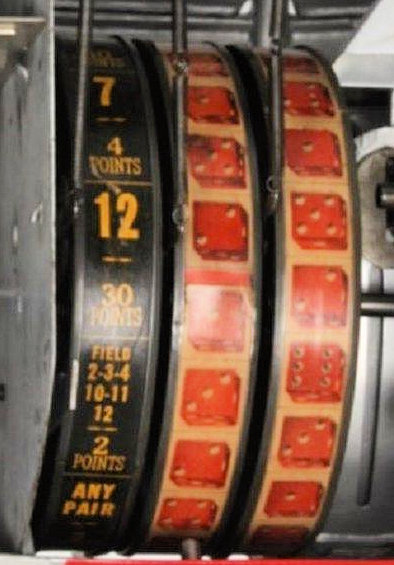
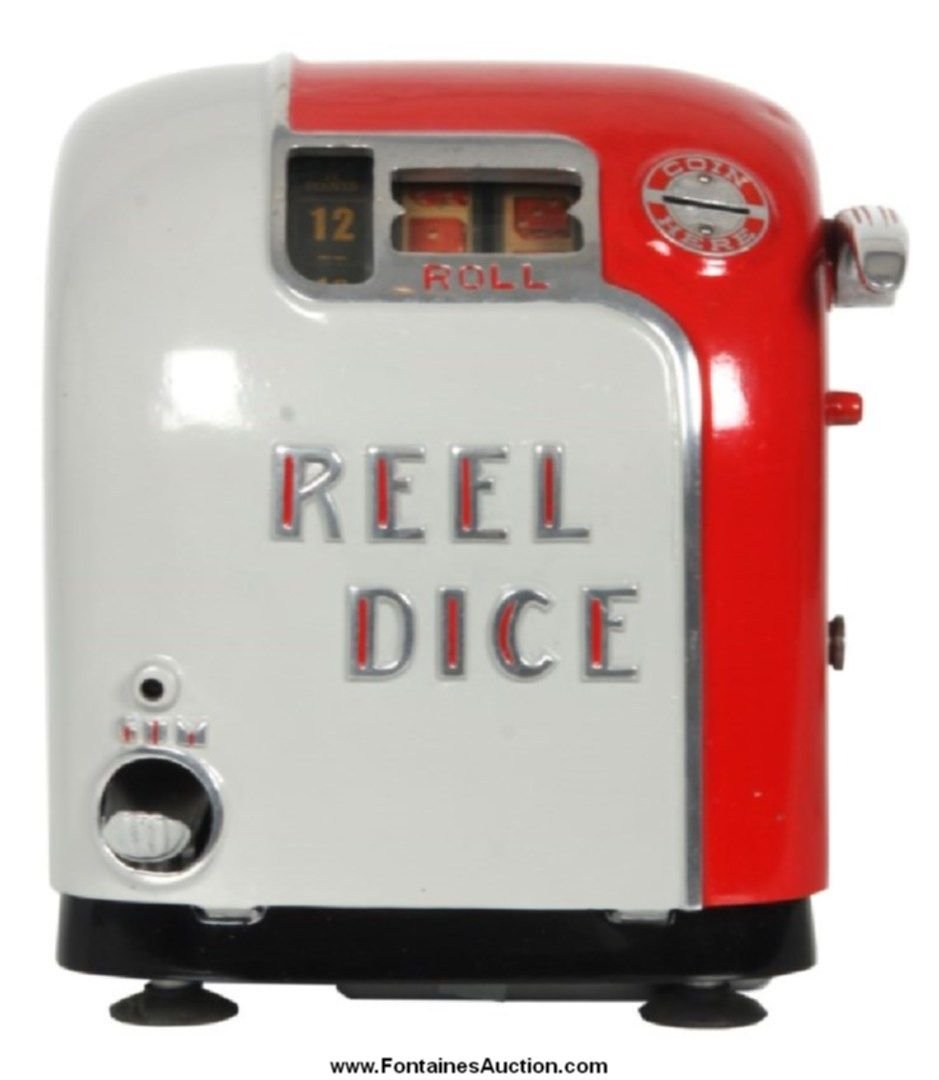
Dice reel strips were quite rare this rather nice late Daval "Reel Dice" is a nice exception
As competition between the makers increased in this lucrative market more complex and interesting machines came along, machines capable of playing blackjack and a form of craps, along with baseball & horse race-themed machines as well as many others.
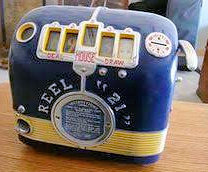
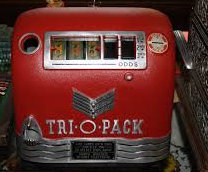
Duval's "Reel 21"dealt you two cards(as numbers) "Tri-o-pack kept the odds hidden till after the then offered the chance to draw 1 or 2 more cards game had run its course
one of the more complex machines, a 1935 Rock-ola "Hold and Draw"
Another interesting and unusual fact about trade stims is their decline. At the start of WW2 (1941 as far as the US was concerned) there was no sign of their popularity waning (at least in bars)and with the slot machine makers moving over to war production (voluntary at first but by law later in the war) the makers shelved their designs ready to shift quickly back into slot production at the war's end.
Some never went back to slot production but the big producers did only to find the trade stim market had died a death, sales were a fraction of pre-war numbers, a few companies brought out new machines in an attempt to renew interest but the trade stim day was passed and by 1950 none of the bandit styles were being made. Many of course continued in use for years with the market drifting back to its general store roots, trade stims were still being made but they had regressed to the coin drop and flick ball/coin style of the early days, as late as 1965 makers were still trying to get the public interested but shopping and drinking habits had changed not least due to the supermarket with its checkouts rather than counters and finally the trade stimulator disappeared altogether.
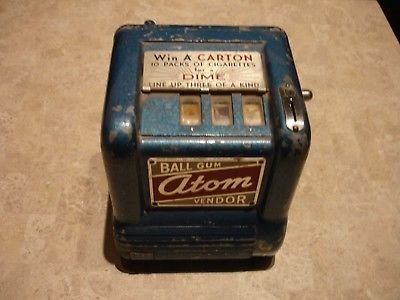
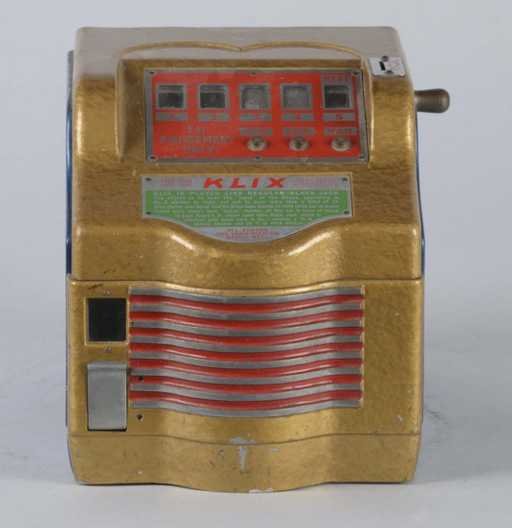
Although both were designed in 1941 Groetchen were not able to get these two machines fully into the market before WW2 stopped production. With the war over the original "Imp" was quickly revamped as the "Atom" (a word much in vogue in 1946) and the "Wings" became the improved "Klix" and "Yankee" machines but none of these sold in large numbers as the market suddenly declined. the reasons for this are many but one clue might be the cost of a game marked on the Atom, no longer 1c but a dime! Although to be fair the prize was a carton of cigarettes (10 packs)
Today these machines are extremely collectable with prices of some more common machines still very reasonable. Their small size and weight is also a big plus for some collectors. As cigarette smoking declines nostalgic and historic interest in these great little machines can only increase and, in my view, collecting trade stimulators has a great future. Ive got five in my slot collection already !
,
